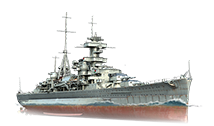

These ships were initially classified Armored ships (Panzerschiff), the British referred to them as pocket battleships and the Germans reclassified them as heavy cruisers in 1940. It would lack the upgraded AA and is therefore be a little worse, making it a good T8 premium. So therefore I would recommend using the Prinz Eugen as the T8 and making the Blüchner (first batch ship sunk in 1940) a premium. However, the Prinz Eugen is a little better, but not better enough to justify making her T9. 12x150mm is nearly equal to the Mogami (soon T8 so making the 150mm Hipper T7 seems reasonable). Therefore I would recommend making the 150mm armed version a T7. I can find no info on the “Super Eugen” for example. I checked WGs preliminary German tree and they either over-tier ships compared to the current tech trees or make stuff up. The German are lacking possible ships suitable for T7. The conning tower was protected by 50-150mm and the turrets by 70-105mm of Wotan armor. The class had 2 armored decks, one 12-30mm and the main one 20-50mm thick. The armored belt had a thickness between 70 and 80mm. Additionally this class carried 4x3x533 torpedo tubes. Prinz Eugen had 20x40mm Flak28 (German name for the Bofors) and 18 20mm guns while Admiral Hipper had 16x40mm and 14x20mm. In 1945 only the Admiral Hipper and Prinz Eugen were still operational.

In late 1944 the remaining 3,7cm SK C/33 guns were replaced by 14x40mm Bofors. Later 4 37mm guns were removed and 20 20mm guns were added. Short range AA was composed of 12x37mm and 8x20mm. 6x2x105mm DP guns formed the secondary battery.

The engines produced 132000 shp and enabled speeds up to 32 knots (Second batch had 136000 shp and 33,5 knots top speed). The first batch (Admiral Hipper and Blücher) was 202 m long, 21,3m beam and 7,7m draft, displacing 18200 tons, while the second batch (Prinz Eugen, Seydlitz and Lützow) was 215m long, 21,8m beam, 7,2m draft and had 18400 tons displacement. These were splitted between 3 cruisers (Admiral Hipper, Blücher and Prinz Eugen) to be armed with 203mm guns in 4 twin turrets and 2 (Seydlitz and Lützow ) with 150mm guns in 4 triple turrets. After the rejection the Versailles treaty Germany signed the Anglo-German Naval Agreement, allowing Germany 51000 tons of heavy cruisers.


 0 kommentar(er)
0 kommentar(er)
